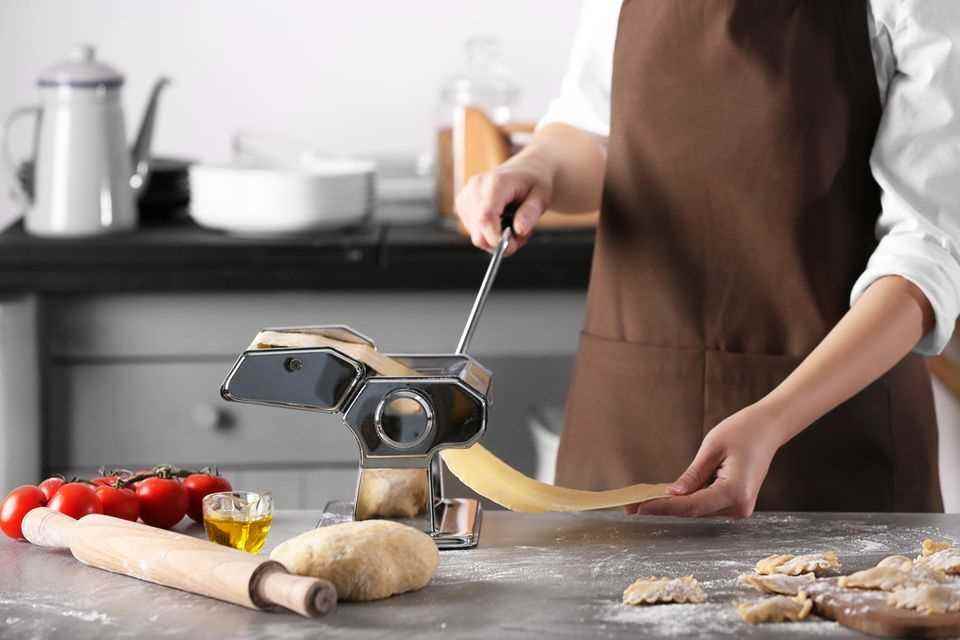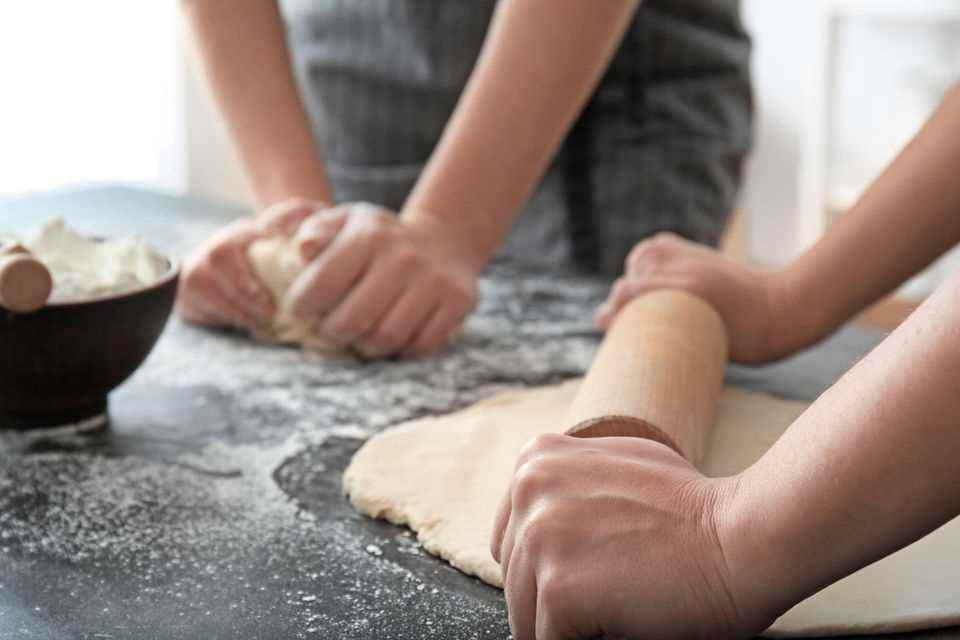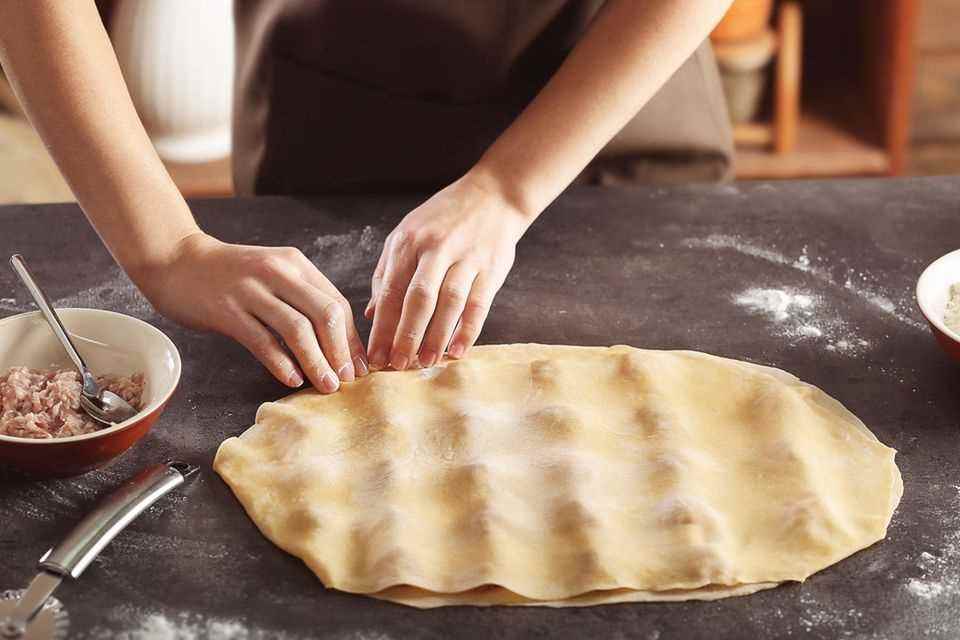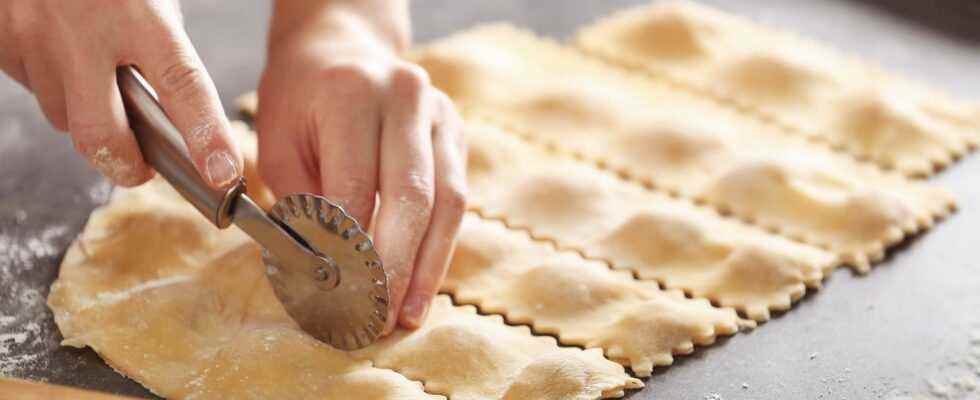Make your own ravioli
Homemade dumplings are easy to make with this recipe
© Africa Studio / Adobe Stock
You want to know how to make ravioli yourself? Then you are exactly right here! We show you step by step how to make the filled dough pieces.
What do you need to make your own ravioli?
You don’t need many ingredients to make ravoili yourself. The dough is very simple and you probably always have the ingredients at home. You can get creative with the filling and you can also use many of the ingredients you can find in your pantry or fridge – but we’ll go into more detail about the filling later.
For delicious ravioli you need the following utensils:
- pasta machine or rolling pin
- flour, water, oil, eggs and salt
- Ingredients for the filling of your choice
- sharp knife or pastry wheel
- possibly cutters for ravioli
- large pot + colander
Classic ravioli dough: the ingredients
The classic ravioli dough requires only a few ingredients: Flour, water and some oil, eggs and salt. But which flour is suitable for pasta? Best you take Italian durum wheat flour (Type 00)but also with normal Wheat Flour (Type 405 or 550) make a good pasta dough. If you want to make noodles with regular wheat flour, you can use that too 50:50 mixed with durum wheat semolina will. This gives the dough an even better consistency.
Good to know: For ravioli dough, calculate 100 grams of flour and 1 egg per person.
Make ravioli yourself: step-by-step instructions
The basic recipe for 4 people
ingredients
- 400 g flour type 405
- 4 eggs
- 2 tbsp olive oil
- ½ tsp salt
- 150 ml lukewarm water
Tip: For a perfect result, your Ingredients are best at room temperature to have. So take the eggs out of the fridge about half an hour before cooking and use lukewarm water. The warm ingredients allow everything to connect better and you get a smooth ravioli dough.
preparation
Step 1: knead the dough
- Put all the ingredients on a work surface or in a bowl and knead them with the dough hook of the hand mixer or with your hands for about 5-10 minutes until the dough is still slightly sticky. However, you should not knead longer, otherwise the ravioli dough will become tough and too sticky. Your ravioli dough is perfect when it expands again after a few seconds after being pressed in with a finger.
- Roll the dough into a ball and place it wrapped in cling film in the fridge to rest for 30 minutes.
Step 2: Roll out the dough
With a pasta machine

© Africa Studio / Adobe Stock
- Knead the dough again with your hands, divide into 4 parts and turn them one after the other through the widest opening of the pasta machine. Leave the remaining pieces of dough wrapped in foil and store them back in the fridge until you work them, so the remaining dough doesn’t dry out while you’re doing it.
- Then tighten the roller opening with each pass and roll the dough through again. As soon as your pasta sheets get too long, you can simply cut them in half with a knife and continue working with the individual sections in stages. Don’t forget to dust the rollers of the machine with flour from time to time, otherwise the dough will stick to them.
- Repeat this process until the pasta dough is 1-2 cm thick.
Without pasta machine

© Africa Studio / Adobe Stock
- Knead the pasta dough again with your hands, cut into quarters and work on the sections one by one. It is best to wrap the rest in cling film again so that it does not dry out.
- Roll out the piece of dough on a floured work surface with a floured rolling pin from the center outwards to a thickness of about 1-2 mm. If it’s thicker, the result will taste too doughy and the filling will sink, if it’s narrower, your ravioli can tear open while cooking.
Step 3: Shape the ravioli © Africa Studio / Adobe Stock
- Divide the strips of dough into 2 halves. They should be the same length, but one half should be a little wider. This allows the wider half to perfectly cover the filling of the ravioli. Just pull the 2nd half apart to make it wider.
- Use a ravioli cutter to indicate where the ravioli should be made on the narrower strip. Make sure that the pasta sheets are not too floury so that they stick together well afterwards. Tip: If you don’t have a ravioli cutter, you can just use a cup or a glass.
- Now you can moisten the edges of the narrower pasta plate with water, egg white or egg yolk.
- Using two teaspoons, place the filling in the middle of the shapes you have drawn. Now place the wider strip of dough on the first one and press down around the fillings so that there is no more air between the layers of dough.
- Cut out the ravioli with the ravioli cutter and store on a floured cloth or wooden board.
Noticed: Use no more than 1 teaspoon of filling per raviolo to avoid spillage. And leave a finger’s breadth around the blob with the filling so that you can later connect the two sheets of dough together. Once you are done with the first portion, cover the finished ravioli with a slightly damp tea towel until ready to cook to keep them from drying out.
Step 4: Cook the ravioli
- Bring plenty of salted water to a boil in a large saucepan and gradually add the ravioli to the boiling water. They’re done when the ravioli float to the surface.
Delicious fillings for homemade ravioli
The filling is of course the best thing about ravioli. If you bite into the small, freshly cooked dumplings and you taste a delicious filling, you usually don’t need any other side dish or sauce. So that you can get some inspiration for the filling, we have a few here Classic ravioli fillings and our 10 unusual favorites compiled.
Classic ravioli fillings:
Ricotta, spinach and parmesan
- 250g spinach
- 300 grams of ricotta
- 1 clove of garlic
- salt, pepper and nutmeg
goat cheese and honey
- 150 g fresh goat cheese
- 200 grams of ricotta
- 2 tbsp honey
- Salt pepper
Gorgonzola and walnut
- 150g Gorgonzola
- 300 grams of cream cheese
- 30 g chopped walnuts
- Salt pepper
Parma ham and parmesan
- 200 grams of Parma ham
- 200 grams of ricotta
- 4 tbsp tomato paste
- 2 tbsp grated Parmesan
- Salt pepper
ground beef
- 300 g ground beef
- 1 tbsp grated Parmesan
- 1 egg
- 1 onion, finely chopped
- 1 clove garlic, pressed
- Salt pepper
Ravioli filling – Our 10 favorites:
- Ravioli with ricotta, lemon and parmesan (you can find the exact recipe here: Ravioli with wild garlic and lemon sauce)
- Ravioli with asparagus, Parmesan and mascarpone (you can find the exact recipe here: Ravioli with asparagus and basil oil)
- Ravioli with pumpkin and pistachio filling
- Ravioli Formaggio, i.e. with cheese filling
- Ravioli with herb filling
- Ravioli with goat’s cream cheese, garlic and aubergine (you can find the exact recipe here: aubergine mezzelune with paprika sauce)
- Ravioli with spinach and cheese
- Ravioli with basil filling
- Ravioli with salmon and celery
- Ravioli with potatoes, rosemary, parmesan and ricotta (you can find the exact recipe here: Ravioli in meat broth)
You should keep this in mind when making the ravioli yourself:
- The filling should always be well seasoned, because it loses some of its flavor during cooking.
- The filling must not be too liquid, otherwise it will leak. The consistency is best spreadable and creamy or kneadable, like a minced meat mass, for example.
- The filling should not be over-portioned, otherwise it will leak out of the ravioli. Half a teaspoon to a whole teaspoon is usually sufficient as a filling for each raviolo.
Do you need a pasta machine to make ravioli yourself?
You don’t necessarily need a pasta machine to make your own ravioli. However, it makes it easier to roll out and the dough sheets are all evenly thick. If you don’t have a pasta machine at home, you can use a classic rolling pin to roll out the dough sheets.
Can you prepare ravioli in advance?
If you cook for guests and want to make the ravioli yourself, you can also prepare them to save time. After shaping, simply place the small pasta pockets on a baking tray lined with baking paper, cover with cling film and place in the fridge.
Freeze ravioli
If you want to prepare a larger quantity of ravioli in advance, you can simply freeze them. Put them on a floured board or a floured plate in the freezer, let them freeze for an hour and then put them together in a freezer bag. That way they don’t stick together. To prepare them, you simply cook them a little longer than the very fresh ravioli in boiling salted water until they float to the top.

